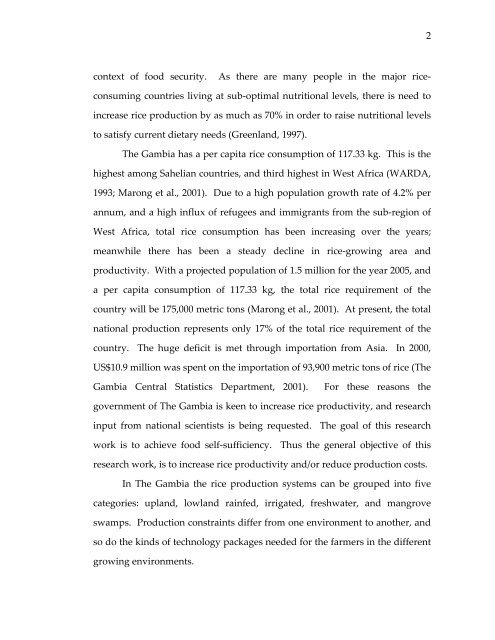Management of rice production systems to increase productivity
Management of rice production systems to increase productivity
Management of rice production systems to increase productivity
Create successful ePaper yourself
Turn your PDF publications into a flip-book with our unique Google optimized e-Paper software.
context <strong>of</strong> food security. As there are many people in the major <strong>rice</strong>‐<br />
consuming countries living at sub‐optimal nutritional levels, there is need <strong>to</strong><br />
<strong>increase</strong> <strong>rice</strong> <strong>production</strong> by as much as 70% in order <strong>to</strong> raise nutritional levels<br />
<strong>to</strong> satisfy current dietary needs (Greenland, 1997).<br />
The Gambia has a per capita <strong>rice</strong> consumption <strong>of</strong> 117.33 kg. This is the<br />
highest among Sahelian countries, and third highest in West Africa (WARDA,<br />
1993; Marong et al., 2001). Due <strong>to</strong> a high population growth rate <strong>of</strong> 4.2% per<br />
annum, and a high influx <strong>of</strong> refugees and immigrants from the sub‐region <strong>of</strong><br />
West Africa, <strong>to</strong>tal <strong>rice</strong> consumption has been increasing over the years;<br />
meanwhile there has been a steady decline in <strong>rice</strong>‐growing area and<br />
<strong>productivity</strong>. With a projected population <strong>of</strong> 1.5 million for the year 2005, and<br />
a per capita consumption <strong>of</strong> 117.33 kg, the <strong>to</strong>tal <strong>rice</strong> requirement <strong>of</strong> the<br />
country will be 175,000 metric <strong>to</strong>ns (Marong et al., 2001). At present, the <strong>to</strong>tal<br />
national <strong>production</strong> represents only 17% <strong>of</strong> the <strong>to</strong>tal <strong>rice</strong> requirement <strong>of</strong> the<br />
country. The huge deficit is met through importation from Asia. In 2000,<br />
US$10.9 million was spent on the importation <strong>of</strong> 93,900 metric <strong>to</strong>ns <strong>of</strong> <strong>rice</strong> (The<br />
Gambia Central Statistics Department, 2001). For these reasons the<br />
government <strong>of</strong> The Gambia is keen <strong>to</strong> <strong>increase</strong> <strong>rice</strong> <strong>productivity</strong>, and research<br />
input from national scientists is being requested. The goal <strong>of</strong> this research<br />
work is <strong>to</strong> achieve food self‐sufficiency. Thus the general objective <strong>of</strong> this<br />
research work, is <strong>to</strong> <strong>increase</strong> <strong>rice</strong> <strong>productivity</strong> and/or reduce <strong>production</strong> costs.<br />
In The Gambia the <strong>rice</strong> <strong>production</strong> <strong>systems</strong> can be grouped in<strong>to</strong> five<br />
categories: upland, lowland rainfed, irrigated, freshwater, and mangrove<br />
swamps. Production constraints differ from one environment <strong>to</strong> another, and<br />
so do the kinds <strong>of</strong> technology packages needed for the farmers in the different<br />
growing environments.<br />
2
















